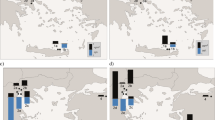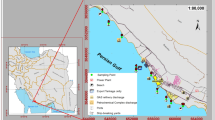Abstract
Concurrent coastal seawater (n = 22), sediment (n = 22), and atmospheric samples (n = 10) were collected in the Aliaga industrial region, Turkey, to explore the spatial variation, sources, and air-seawater exchange of polycyclic aromatic hydrocarbons (PAHs) and polychlorinated biphenyls (PCBs). Seawater Σ16PAH concentrations (particle + dissolved) ranged between 5107 and 294,624 pg L−1, while Σ41PCB concentrations were in the range of 880–50,829 pg L−1. Levels in sediments were highly variable ranging between 35.5–49,682 and 2.7–2450 μg kg−1 in dry weight for Σ16PAHs and Σ41PCBs, respectively. Atmospheric concentrations varied between 1791–274,974 and 104–20,083 pg m−3 for Σ16PAHs and Σ41PCBs, respectively. Sediment organic matter (OM) content and levels of Σ16PAHs and Σ41PCBs correlated weakly (r 2 = 0.19–0.23, p < 0.05) suggesting that the spatial variations of PAHs and PCBs were mainly affected by local sources rather than their sorption to OM. The geographical distribution of PAH and PCB concentrations in air, seawater, and sediment and factor analysis on the sediment levels pointed out that the major sources in the region are steel plants, petroleum refinery, petrochemical complex, ship breaking, loading/unloading activities at the ports, vehicular emissions, and fossil fuel combustion emissions. The direction of the air-seawater exchange was also explored by estimating seawater fugacity fractions of PAHs and PCBs. For PAHs, the number of cases implying deposition (43.0%) and volatilization (39.5%) was similar, while for PCBs, the number of cases implying volatilization (60.4%) was much higher compared to deposition (21.6%). Fugacity fractions were generally <0.36 (deposition) at the sites close to industrial and ship breaking activities where the highest seawater and sediment levels were measured, implying that atmospheric deposition is an important mechanism affecting seawater and sediment PAH and PCB levels.








Similar content being viewed by others
References
Aydin YM, Kara M, Dumanoglu Y, Odabasi M, Elbir T (2014) Source apportionment of polycyclic aromatic hydrocarbons (PAHs) and polychlorinated biphenyls (PCBs) in ambient air of an industrial region in Turkey. Atmos Environ 97:271–285
Bamford HA, Poster DL, Baker JE (1999) Temperature dependence of Henry’s law constants of thirteen polycyclic aromatic hydocarbons between 4 degrees C and 31 degrees C. Environ Toxicol Chem 18:1905–1912
Bigus P, Tobiszewski M, Namiesnik J (2014) Historical records of organic pollutants in sediment cores. Mar Pollut Bull 78:26–42
Bozlaker A, Odabasi M, Muezzinoglu A (2008a) Dry deposition and soil-air gas exchange of polychlorinated biphenyls (PCBs) in an industrial area. Environ Pollut 156:784–793
Bozlaker A, Muezzinoglu A, Odabasi M (2008b) Atmospheric concentrations dry deposition and air-soil exchange of polycyclic aromatic hydrocarbons (PAHs) in an industrial region in Turkey. J Hazard Mater 153:1093–1102
Callen MS, Lopez JM, Mastral AM (2012) Apportionment of the airborne PM10 in Spain episodes of potential negative impact for human health. J Environ Monit 14:1211–1220
Cetin B, Odabasi M (2007) Air-water exchange and dry deposition of polybrominated diphenyl ethers at a coastal site in Izmir Bay Turkey. Environ Sci Technol 41:785–791
Cetin B, Odabasi M (2008) Atmospheric concentrations and phase partitioning of polybrominated diphenyl ethers (PBDEs) in Izmir Turkey. Chemosphere 71:1067–1078
Cetin B, Odabasi M, Bayram A (2016) Wet deposition of persistent organic pollutants (POPs) in Izmir Turkey. Environ Sci Pollut Res 23:9227–9236
Chen J, Xue X, Schramm KW, Quan X, Yang F, Kettrup A (2002) Quantitative structure-property relationship for octanol-air partition coefficients of polychlorinated biphenyls. Chemosphere 48:535–544
Demircioglu E, Sofuoglu A, Odabasi M (2008) Air-water exchange of polycyclic aromatic hydrocarbons at a coastal site in Izmir Bay (in Turkish) National Air Pollution and Control Symposium 220-235 October 22-25, 2008, Hatay, Turkey
Demircioglu E, Sofuoglu A, Odabasi M (2011) Atmospheric concentrations and phase partitioning of polycyclic aromatic hydrocarbons in Izmir Turkey. Clean-Soil Air Water 39:319–413
Feo ML, Sprovieri M, Gherardi S, Sammartino S, Marsella E (2011) Polycyclic aromatic hydrocarbons and polychlorinated biphenyls in the harbour of Naples (Southern Italy): time and spatial distribution patterns. Environ Monit Assess 174:445–459
Finizio A, Mackay D, Bidleman TF, Harner T (1997) Octanol–air partition coefficient as a predictor of partitioning of semivolatile organic chemicals. Atmos Environ 31:289–2296
Frignani M, Bellucci LG, Favotto M, Albertazzi S (2005) Pollution historical trends as recorded by sediments at selected sites of the Venice Lagoon. Environ Int 31:1011–1022
Fung CN, Zheng GJ, Connell DW, Zhang X, Wong HL, Giesy JP, Fang Z, Lam PKS (2005) Risks posed by trace organic contaminants in coastal sediment on the Pearl River Delta, China. Mar Pollut Bull 50:1036–1049
Han XY, Wang ZY, Zhai ZC, Wang LS (2006) Estimation of n-octanol/water partition coefficients (Kow) of all PCB congeners by ab initio and a Cl substitution position method. QSAR Comb Sci 25:333–341
Harner T, Bidleman TF (1996) Measurements of octanol-air partition coefficients for polychlorinated biphenyls. J Chem Eng Data 41:895–899
Harner T, Bidleman TF (1998) Octanol–air partition coefficient for describing particle/gas partitioning of aromatic compounds in urban air. Environ Sci Technol 32:1494–1502
Harner T, Su K, Genualdi S, Karpowicz J, Ahrens L, Mihele C, Schuster J, Charland J-P, Narayan J (2013) Calibration and application of PUF disk passive air samplers for tracking polycyclic aromatic compounds (PACs). Atmos Environ 75:123–128
Harner T, Mitrovic M, Ahrens L, Schuster J (2014) Characterization of PUF disk passive air samplers for new priority chemicals: a review. Organohalogen Compd 76:11–29
Hu D, Martinez A, Hornbuckle KC (2011) Sedimentary records of non-Aroclor and Aroclor PCB mixtures in the Great Lakes. J Great Lakes Res 37:359–364
Jin RH, Park SU, Park JE, Kim JG (2012) Polychlorinated biphenyl congeners in river sediments: distribution and source identification using multivariate factor analysis. Arch Environ Contam Toxicol 62:411–423
Jonker MTO, Koelmans AA (2002) Sorption of polycyclic aromatic hydrocarbons and polychlorinated biphenyls to soot and soot-like materials in the aqueous environment: mechanistic considerations. Environ Sci Technol 36:3725–3734
Kaya E, Dumanoglu Y, Kara M, Altiok H, Bayram A, Elbir T, Odabasi M (2012) Spatial and temporal variation and air-soil exchange of atmospheric PAHs and PCBs in an industrial region. Atmos Pollut Res 3:435–449
Kwan CS, Takada H, Boonyatumanond R, Kato Y, Mizukawa K, Ito M, Dung LQ, Zakaria MP, Santiago EC (2014) Historical occurrences of polybrominated diphenyl ethers and polychlorinated biphenyls in Manila Bay Philippines and in the upper Gulf of Thailand. Sci Total Environ 470-471:427–437
Lee RGM, Coleman P, Jones JL, Jones KC, Lohmann R (2005) Emission factors and importance of PCDD/Fs PCBs PCNs PAHs and PM10 from the domestic burning of coal and wood in the UK. Environ Sci Technol 39:1436–1447
Markovic MZ, Prokop S, Staebler RM, Liggio J, Harner T (2015) Evaluation of the particle infiltration efficiency of three passive samplers and the PS-1 active air sampler. Atmos Environ 112:289–293
Motelay-Massei A, Ollivon D, Garban B, Chevreuil M (2003) Polycyclic aromatic hydrocarbons in bulk deposition at a suburban site: assessment by principal component analysis of the influence of meteorological parameters. Atmos Environ 37:3135–3146
National Library of Medicine (NLM) 2016 Specialized Information Services (SIS) Toxnet Available from: http://toxnet.nlm.nih.gov/
Ni N, Yalkowsky H (2003) Prediction of Setschenow constants. Int J Pharm 254:167–172
Nizzetto L, Lohmann R, Gioia R, Jahnke A, Temme C, Dachs J, Herckes P, Di Guardo A, Jones KC (2008) PAHs in air and seawater along a North-South Atlantic transect: trends processes and possible sources. Environ Sci Technol 42:1580–1585
Odabasi M, Cetin E, Sofuoglu A (2006a) Determination of octanol-air partition coefficients and supercooled liquid vapor pressures of PAHs as a function of temperature: application to gas-particle partitioning in an urban atmosphere. Atmos Environ 40:6615–6625
Odabasi M, Cetin B, Sofuoglu A (2006b) Henry’s law constant octanol-air partition coefficient and supercooled liquid vapor pressure of carbazole as a function of temperature: application to gas/particle partitioning in the atmosphere. Chemosphere 62:1087–1096
Odabasi M, Cetin B, Demircioglu E, Sofuoglu A (2008) Air–water exchange of polychlorinated biphenyls (PCBs) and organochlorine pesticides (OCPs) at a coastal site in Izmir Bay Turkey. Mar Chem 109:115–129
Odabasi M, Bayram A, Elbir T, Seyfioglu R, Dumanoglu Y, Bozlaker A, Demircioglu H, Altiok H, Yatkin S, Cetin B (2009) Electric arc furnaces for steel-making: hot spots for persistent organic pollutants. Environ Sci Technol 43:5205–5211
Odabasi M, Ozgunerge Falay E, Tuna G, Altiok H, Kara M, Dumanoglu Y, Bayram A, Tolunay D, Elbir T (2015) Biomonitoring the spatial and historical variations of persistent organic pollutants (POPs) in an industrial region. Environ Sci Technol 49:2105–2114
Schenker U, MacLeod M, Scheringer M, Hungerbuhler K (2005) Improving data quality for environmental fate models: a least-squares adjustment procedure for harmonizing physicochemical properties of organic compounds. Environ Sci Technol 39:8434–8441
Shoeib M, Harner T (2002) Characterization and comparison of three passive air samplers for persistent organic pollutants. Environ Sci Technol 36:4142–4151
Takasuga T, Kumar KS, Noma Y, Sakai S (2005) Chemical characterization of polychlorinated biphenyls,-dibenzo-p-dioxins, and-dibenzofurans in technical Kanechlor PCB formulations in Japan. Arc Environ Con Tox 49:385–395
Takasuga T, Senthilkumar K, Matsumura T, Shiozaki K, Sakai SI (2006) Isotope dilution analysis of polychlorinated biphenyls (PCBs) in transformer oil and global commercial PCB formulations by high resolution gas chromatography-high resolution mass spectrometry. Chemosphere 62:469–484
Ten Hulscher TEM, Van Der Velde LE, Bruggeman WA (1992) Temperature dependence of Henry’s law constant for selected chlorobenzenes, polychlorinated biphenyls and polycyclic aromatic hydrocarbons. Environ Toxicol Chem 22:1179–1188
Tian YZ, Li WH, Shi GL, Feng YC, Wang YQ (2013) Relationships between PAHs and PCBs and quantitative source apportionment of PAHs toxicity in sediments from Fenhe reservoir and watershed. J Hazard Mater 248:89–96
Totten LA, Brunciak PA, Gigliotti CL, Dachs J, Glenn TR IV, Nelson ED, Eisenreich SJ (2001) Dynamic air-water exchange of polychlorinated biphenyls in the New York-New Jersey Harbor Estuary. Environ Sci Technol 35:3834–3840
Valavanidis A, Vlachogianni T, Triantafillaki S, Dassenakis M, Androutsos F, Scoullos M (2008) Polycyclic aromatic hydrocarbons in surface seawater and in indigenous mussels (Mytilus galloprovincialis) from coastal areas of the Saronikos Gulf (Greece). Estuar Coast Shelf Sci 79:733–739
Virtual Computational Chemistry Laboratory (VCCL) 2016 Available from: http://146.107.217.178/lab/alogps/starthtml
Wang DG, Alaee M, Byer J, Liu YJ, Tian CG (2011) Fugacity approach to evaluate the sediment–water diffusion of polycyclic aromatic hydrocarbons. J Environ Monit 13:1589–1596
Wurl O, Obbard JP (2006) Distribution of organochlorine compounds in the sea-surface microlayer water column and sediment of Singapore’s coastal environment. Chemosphere 62:1105–1115
Zhang X, Schramm KW, Henkelmann B, Klimn C, Kaune A, Kettrup A, Lu P (1999) A method to estimate the octanol-air partition coefficient of semivolatile organic compounds. Anal Chem 71:3834–3838
Zheng GJ, Richardson BJ (1999) Petroleum hydrocarbons and polycyclic aromatic hydrocarbons (PAHs) in Hong Kong marine sediment. Chemosphere 38:2625–2632
Acknowledgments
The present study was supported in part by the “Assessment of current status of Aliaga industrial region for air pollution” project conducted by Dokuz Eylul University for the Turkish Ministry of Environment and Urbanism and for the industries located in Aliaga region.
Author information
Authors and Affiliations
Corresponding author
Additional information
Responsible editor: Hongwen Sun
Rights and permissions
About this article
Cite this article
Odabasi, M., Dumanoglu, Y., Kara, M. et al. Spatial variation of PAHs and PCBs in coastal air, seawater, and sediments in a heavily industrialized region. Environ Sci Pollut Res 24, 13749–13759 (2017). https://doi.org/10.1007/s11356-017-8991-8
Received:
Accepted:
Published:
Issue Date:
DOI: https://doi.org/10.1007/s11356-017-8991-8




